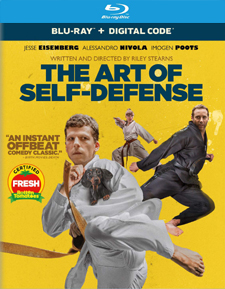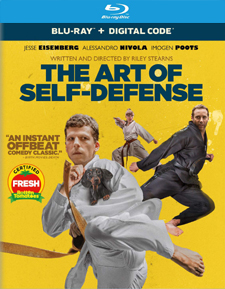Art of Self-Defense, The (Blu-ray Review)

Director
Riley StearnsRelease Date(s)
2019 (October 15, 2019)Studio(s)
End Cue/Bleecker Street (Universal Pictures Home Entertainment)- Film/Program Grade: B-
- Video Grade: B
- Audio Grade: B
- Extras Grade: C
Review
A dramatic thriller with subtle comic touches, The Art of Self-Defense chronicles the dark journey of a lonely young man who turns to karate as a means to gain courage and self-esteem in an often intimidating world.
Casey (Jesse Eisenberg), an anxious, socially awkward accountant, spends his life outside work sitting on his couch and watching TV with his dachshund. Out late one night to get dog food, he’s attacked by a roving motorcycle gang who beat him so badly that he winds up in the hospital. Afterwards, he comes across a karate school and observes a lesson. He talks to the owner, known only as Sensei (Alessandro Nivola), who quietly explains the benefits of karate training. Seeing Casey’s lack of self-esteem, the charismatic Sensei convinces him that karate can change his life by building his confidence and freeing him from living in a constant state of fear. Casey signs up.
Casey likes the discipline, the workouts, and especially the philosophy espoused by Sensei. The dojo has brought a new focus into his life. He feels more self-assured, becomes more assertive at work, and concentrates all his attention on the lessons.
He later discovers there’s a special night class for those who have achieved black belt status. Though Casey is only a yellow belt, Sensei asks him to join the class. Casey feels honored. The class is all men with one exception—Anna (Imogen Poots), who feels she is being held back from advancing because of her gender. The night class differs from the day classes in that the participants are more violent with one another and are tasked with extending the violence beyond the dojo.
Writer-director Riley Stearns is a master at establishing suspense and building it as the film progresses. Little is telegraphed by the screenplay, and we become immersed in Casey’s transformation from timid, nearly invisible weakling to macho, in-your-face badass.
Eisenberg, known for playing twitchy nerds, is right at home in the role of Casey, though it differs significantly from anything else he’s done on screen. There’s a definite arc to his performance, from fear to self-reliance to angry disillusionment. As we share his experience through his eyes, we learn more as he uncovers the dark secrets of the karate school and its students.
Nivola convinces us that Sensei has the ability to seduce innocents by reaching them on their most vulnerable level. Like a cult leader, he demands unconditional loyalty and can even explain heinous crimes as hard lessons of advanced training, all the while looking out only for himself. He is soft spoken, never high-pressure, and promises to make a man out of Casey.
Rated R, The Art of Self-Defense follows Casey’s skewed journey of self-empowerment. The movie cleverly blends themes of toxic masculinity, loneliness, hero worship, disillusionment, random violence, vengeance, and redemption, while satirizing society’s view of what constitutes being a man. Like Fight Club, The Art of Self-Defense has its secrets, with perhaps the biggest unexpected turn of events occurring in the film’s finale.
The Blu-ray, featuring 1080p High Definition resolution, is presented in the widescreen aspect ratio of 1.85:1. The widescreen is especially effective in compositions in which the dojo students are shown lined up. The actors fill the screen and there’s little dead space at the edges of the frame. The color palette leans toward darker tones, especially in Casey’s apartment, illuminated only by small lamps and the television screen. In the nighttime scene in which Casey goes out to buy dog food, black-clad bikers on black motorcycles create an ominous mood. In the dojo scenes, the white karate uniforms (Gi) of the students dominate, contrasting with Sensei’s black Gi. Outdoor daytime scenes are cloudy and grey, visually underscoring Casey’s gloomy sense of self-worth.
The soundtrack is English 5.1 DTS-High Definition Master Audio. English subtitles are provided for the hearing impaired. Dialogue is formal, with characters speaking full sentences in an often dry, deadpan fashion. Funny lines are underplayed, such as when Casey asks a gun dealer for a gun he can hold in his hand and the dealer replies with an expressionless, “You mean a hand gun." Director Stearns starts the film very quietly, as we see Casey in his daily routine. In a restaurant, he sits motionless as two foreigners “play a game,” speculating about the sad-looking Casey sitting alone. Music plays softly in the background. In the dojo scenes, sounds of grunting, bodies slamming onto mats, and violent punches emphasize the sport’s physicality. Approaching motorcycle engines enhance the tension as Casey walks home alone at night.
Bonus materials on the Blu-ray release include An Important Message From Sensei and cast and crew interviews. A Digital code on a paper insert is included.
An Important Message From Sensei – This is an elaborate spoof TV ad advertising a 12-volume collection of videos espousing masculinity and self confidence and includes the titles Test of Testosterone, Soft Rock: Music for the Weak, and Why Own a Dog When You Can Train a Wolf? Actor Alessandro Nivola as Sensei is shown in scenes from the dojo. This clever featurette contains simulated VHS defects, suggesting the heyday of self-help videos marketed on late-night television.
Cast and Crew Interviews – Director Riley Stearns and three of the movie’s stars provide brief interviews.
Jesse Eisenberg – He was impressed with the uniqueness of the script, thinking at first that it was just another story of a nerd. He liked the way the character of Casey is transformed and “all the strange and unexpected things” that happen. His character interacts with people in a “babyish” way. Eisenberg prefers doing movies that don’t adhere to naturalism. As an actor, he finds it freeing. The performance style is formal with characters speaking in complete sentences, often with a flat, unemotional delivery. The film’s “amazing emotional undercurrent” keeps the audience off balance.
Alessandro Nivola – He didn’t initially understand director Riley Stearns’ particular brand of humor. The challenge was to bring humanity to Sensei while honoring the film’s surreal style. Dialogue has to be delivered in a heartfelt fashion. To Sensei, karate represents a way of getting back at the world. Nivola had to determine the “rhythms of the character.” As a young man, Sensei was like Casey.
Riley Stearns – Director Stearns took a few months to write the script. The idea came from his concerns about toxic masculinity. Casey is intimidated by other men, and the film satirizes that. Stearns didn’t want the film to be strictly a comedy or a martial arts film. The karate scenes are edited at a slower pace and with fewer cuts than typical martial arts films. His writing style is literal. As a young man, he wrote scripts in the style of others (Quentin Tarantino, Wes Anderson) before developing his own voice.
Imogen Poots – The actress thought the film’s “tone felt very new.” She had to believe in the style, often delivering dialogue in deadpan fashion.
– Dennis Seuling

